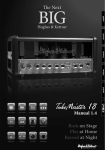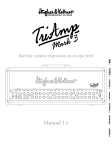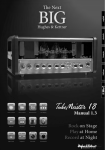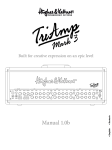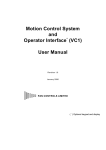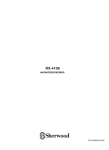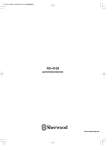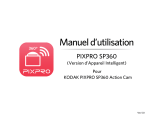Download Sherwood RX-4209 Operating instructions
Transcript
RX-4209
AM/FM STEREO RECEIVER
OPERATING INSTRUCTIONS
Introduction
READ THIS BEFORE OPERATING YOUR UNIT
This symbol is intended to alert the user to the
presence of uninsulated "dangerous voltage"
within the product's enclosure that may be
of sufficient magnitude to constitute a risk of
electric shock to persons.
CAUTION
RISK OF ELECTRIC SHOCK
DO NOT OPEN
CAUTION:
TO REDUCE THE RISK OF ELECTRIC
SHOCK, DO NOT REMOVE COVER
(OR BACK). NO USER-SERVICEABLE
PARTS INSIDE. REFER SERVICING TO
QUALIFIED SERVICE PERSONNEL.
This symbol is intended to alert the user to
the presence of important operating and
maintenance (servicing) instructions in the
literature accompanying the appliance.
WARNING : TO REDUCE THE RISK OF FIRE OR ELECTRIC SHOCK, DO NOT EXPOSE THIS APPLIANCE
TO RAIN OR MOISTURE.
Caution regarding installation
Note : For heat dispersal, do not install this unit in a confined space such as a bookcase or similar enclosure.
Note
Wall
vu
vmm
htVmtGz{lylvGyljlp}lyGy T[YW`
Do not block ventilation openings or stack other equipment on the top.
FOR YOUR SAFETY
EUROPE
AUSTRALIA
220 V
240 V
Units shipped to Australia are designed for operation on 230 V AC only.
To ensure safe operation, the three-pin plug supplied must be inserted only into a standard three-pin
power point which is effectively earthed through the normal household wiring. Extension cords used
with the equipment must be three-core and be correctly wired to provide connection to earth.
Improper extension cords are a major cause of fatalities. The fact that the equipment operates
satisfactorily does not imply that the power point is earthed and that the installation is completely
safe. For your safety, if in any doubt about the effective earthing of the power point, consult a
qualified electrician.
PAN-EUROPEAN UNIFIED VOLTAGE
All units are suitable for use on supplies 220-240 V AC.
CAUTION
• Leave a space around the unit for sufficient ventilation.
• Avoid installation in extremely hot or cold locations, or in an area that is exposed to direct sunlight or heating equipment.
• Keep the unit free from moisture, water, and dust.
• Do not let foreign objects in the unit.
• The ventilation should not be impeded by covering the ventilation openings with items, such as newspapers, table-cloths,
curtains, etc.
• No naked flame sources, such as lighted candles, should be placed on the unit.
• Please be care the environmental aspects of battery disposal.
• The unit shall not be exposed to dripping or splashing for use.
• No objects filled with liquids, such as vases, shall be placed on the unit.
• Do not let insecticides, benzene, and thinner come in contact with the set.
• Never disassemble or modify the unit in any way.
■Notes on the AC power cord and the wall outlet.
• The unit is not disconnected from the AC power source(mains) as long as it is connected to the wall outlet, even if the unit
has been turned off.
• To completely disconnect this product from the mains, disconnect the plug from the wall socket outlet.
• When setting up this product, make sure that the AC outlet you are using is easily accessible.
• Disconnect the plug from the wall outlet when not using the unit for long periods of time.
2
Information for Users on Collection and Disposal of Old Equipment and used Batteries
These symbols on the products, packaging, and/or accompanying documents mean that used electrical and
electronic products and batteries should not be mixed with general household waste. For proper treatment,
recovery and recycling of old products and used batteries, please take them to applicable collection points, in
accordance with your national legislation.
By disposing of these products and batteries correctly, you will help to save valuable resources and prevent any
potential negative effects on human health and the environment which could otherwise arise from inappropriate
waste handling.
For more information about collection and recycling of old products and batteries, please contact your local
municipality, your waste disposal service or the point of sale where you purchased the items.
[Information on Disposal in other Countries outside the European Union]
These symbols are only valid in the European Union. If you wish to discard these items, please contact your local
authorities or dealer and ask for the correct method of disposal.
Note for the battery symbol (bottom two symbol examples):
The sign Pb below the symbol for batteries indicates that this batteries contains lead.
CONTENTS
Introduction...............................................................................................................................................2
• READ THIS BEFORE OPERATING YOUR UNIT........................................................................................2
System Connections................................................................................................................................4
Front Panel Controls................................................................................................................................6
Remote Controls.......................................................................................................................................7
• REMOTE CONTROL OPERATION RANGE................................................................................................8
• LOADING BATTERIES.................................................................................................................................8
Operations................................................................................................................................................9
• LISTENING TO A PROGRAM SOURCE......................................................................................................9
• LISTENING TO RADIO BROADCASTS.....................................................................................................12
• RECORDING..............................................................................................................................................15
• OTHER FUNCTIONS.................................................................................................................................15
Troubleshooting Guide..........................................................................................................................16
Specifications.........................................................................................................................................17
3
System Connections
• Do not plug the AC input cord into the wall AC outlet until all connections are completed.
• Be sure to connect the white RCA pin cords to the L (left) and the red RCA pin cords to the R (right) jacks
when making audio connections.
• Make connections firmly and correctly. If not, it can cause loss of sound, noise or damage to the receiver.
• If the electricity fails or the AC input cord is left unplugged for more than a week, the memorized contents will
be cleared. Should this happen, memorize them again.
hjGpuw|{
zwlhrlyz
R
L
GND
hu{luuh
wovuv
nuk
jk
h|GX
pu
ht
svvw
v|{
h|GY
pu
A
v|{
L
L
R
R
B
mt
^\GGG
1. CONNECTING ANTENNAs
FM Outdoor Antenna
AM Outdoor Antenna
FM Indoor Antenna
AM Loop Antenna
ANTENNA
GND
AM
LOOP
FM
75
2. CONNECTING PHONO
▄ Note
• Do not connect the turntable with MC type
cartridge directly. If so, use a separate head
amplifier or step-up transformer.
GND
PHONO
L
• Change the position of the
FM indoor antenna until
you get the best reception
of your favorite FM stations.
• A 75 Ω outdoor FM antenna
may be used to further
improve the reception.
Disconnect the indoor
antenna before replacing it
with the outdoor one.
• Place the AM loop antenna
as far as possible from the
receiver, TV set, speaker
cords and the AC input
cord and set it to a direction
for the best reception.
• If the reception is poor with
the AM loop antenna, an
AM outdoor antenna can
be used in place of the AM
loop antenna.
Turntable with MM
type cartridge
R
4
3. CONNECTING AUDIO COMPONENTS
• The AUX1 and AUX2 jacks may also be connected to an additional component such as MD recorder, tape
deck, etc.
wovuv jk
h|GX
pu
h|GY
v|{
pu
v|{
L
L
R
R
CD player
Tape deck
REC IN
PLAY(LINE) OUT
MD recorder, etc.
PLAY OUT
REC(LINE) IN
4. CONNECTING SPEAKERS
• Usually SPEAKER A terminals are used for only a pair of
speakers. When you have another pair of speakers, SPEAKER B
terminals can be used.
Speaker A
• Never short-circuit the + and - speaker cords.
Right
Left
SPEAKERS
R
L
• Be sure to connect speakers firmly and correctly according to the
channel (left and right) and the polarity (+ and -).
▄ Note
• For safe amplifier operation, use the speakers with impedance of
over 8Ω when you use only SPEAKER A or B terminals and use
the speakers with impedance of over 16Ω when you use both
SPEAKER A and B terminals.
A
B
Right
Left
Speaker B
5. AC INPUT CORD
• Plug the cord into a wall AC outlet.
5
Front Panel Controls
vu
vmm
htVmtGz{lylvGyljlp}lyGy T[YW`
1.
2.
3.
4.
5.
6.
7.
8.
POWER switch
POWER ON / STANDBY button
STANDBY indicator
HEADPHONE jack
SPEAKER A/B button
BAND button
TUNING /PRESET MODE button
MEMORY button
9. BLANCE button
10.TONE MODE button
11.ADJUST UP/DOWN button
12.INPUT SELECTOR knob
13.MASTER VOLUME knob
14.REMOTE SENSOR
15.FLUORESCENT DISPLAY
For details, see below.
▄ FLUORESCENT DISPLAY
1.Input, frequency, volume level, operating
information, etc.
2. HEADPHONE indicator
3. STEREO indicator
4. TUNED indicator
5.
6.
7.
8.
9.
6
SLEEP indicator
Preset number, sleep time display
MEMORY indicator
PRESET indicator
TONE DIRECT indicator
Remote Controls
POWER ON button
STANDBY button
SPEAKER A/B buttons
NUMERIC buttons
DIMMER button
SLEEP button
PRESET SCAN button
MONO/STEREO button
INPUT SELECTOR buttons
MUTE button
MEMORY buttons
VOLUME UP/DOWN (▲/▼) buttons
TUNING UP/DOWN (►/◄) buttons
PRESET UP/DOWN (▲/▼) buttons
BALANCE L/R buttons
BASS UP/DOWN (+/-) buttons
TREBLE UP/DOWN (+/-) buttons
7
REMOTE CONTROL OPERATION RANGE
vu
vmm
htVmtGz{lylvGyljlp}lyGy T[YW`
• Use the remote control unit within a range of
about 7 meters (23 feet) and angles of up to 30
degrees aiming at the remote sensor.
LOADING BATTERIES
1. Remove the cover.
2.Load two batteries (“AAA” size, 2x1.5V) matching
the polarity.
• Remove the batteries when they are not used for a
long time.
• Do not use the rechargeable batteries(Ni-Cd type).
8
Operations
LISTENING TO A PROGRAM SOURCE
Before operation
• Push the POWER switch.
vu
• This unit enters the standby mode and the
STANDBY indicator lights up blue. The lighting
of STANDBY indicator means that the receiver
is not disconnected from the AC mains and a
small amount of current is retained to support the
memorized contents and operation readiness.
• To switch the power off, push the POWER switch
again. Then the power is cut off and the STANDBY
indicator goes off.
vmm
1. In the standby mode, turn the power on.
• When the POWER ON button on the remote
control or the ON/STANDBY button on the front
panel is pressed, this unit is turned on to enter the
operating mode.
• In the standby mode, if an INPUT SELECTOR
button on the remote control is pressed, the unit
is turned on automatically and the desired input is
selected.
• In the operating mode, when the STANDBY button
on the remote control or ON/STANDBY button
on the front panel is pressed, then it enters the
standby mode.
2. Switch the desired speakers on.
• Then the corresponding speaker indication(“SPK
A(or/and) B”) is displayed and the sound can be
heard from the speakers connected to the selected
speaker terminals.
• When using the headphones for private listening,
press the corresponding SPEAKER button to
switch off both A and B speakers (“H” indicator
lights up).
3. Select the desired input source.
• Each time the INPUT SELECTOR knob
is rotated, the input source changes as
follows:
Tuner
CD
(Frequency display)
9
AUX2
AUX1
PHONO
4. Operate the selected component for playback.
5. Adjust the volume to a comfortable listening level.
6. To mute the sound.
• “MUTE” flickers.
• To resume the previous sound level, press this
button again.
• When adjusting the volume, the muting effect is
turned off.
7. To listen with the headphones.
• Be sure to switch off both A and B speakers.
▄ Note
• Be careful not to set the volume too high when
using headphone.
Adjusting the tone(bass and treble)
8. Enter the tone mode.
• Each time this button is pressed, the
corresponding tone mode is selected and shown
for 3 seconds as follows:
BASS
TRBL
TON CTRL
▄ Note
• When the tone direct function is activated, the
tone mode cannot be entered and “TON DIR”
flickers for 3 seconds.
10
9. At the desired tone mode, adjust the tone as desired.
• If the tone display disappears, start from the
step 8 again.
• When pressing the TREBLE UP/DOWN (+/-) or
BASS UP/DOWN (+/-) buttons, you need not
select the desired tone mode on the step 8.
• The tone level can be adjusted within the range
of -10 ~ +10 dB.
• While displaying “TON CTRL”, if the ADJUST
UP/DOWN knob is rotated, “TON DIR” will be
displayed, and vice versa.
• “TON DIR” is displayed, “DIR” lights up and the
sound that bypasses the tone circuitry will be
heard.
▄ Note
• Extreme settings at high volume may damage
your speakers.
• In general, the bass and treble levels are
adjusted to 0 dB.
Adjusting the sound volume balance
10. Enter the balance mode.
• “BAL” and the balance level is displayed for 3
seconds.
11. Adjust the sound volume balance between the left and right speakers.
• If the balance display disappears, start from the
step 10 again.
• When pressing the BALANCE L/R buttons, you
need not select the balance mode on the step 11.
• The balance level can be adjusted within the
range of L10 ~ R10 dB.
▄ Note
• In general, the balance level is set to 0 dB.
11
LISTENING TO RADIO BROADCASTS
Auto tuning
1. Select the tuner and then the desired band.
• Each time the BAND button is pressed, the
tuner is selected and then the band changes as
follows:
FM ST
BAND
FM MONO
AM
(Frequency display)
FREQUENCY
2. Select the tuning mode.
• Each time this button is pressed, the mode
changes as follows:
Tuning mode : “PRESET” goes off.
Preset mode : “PRESET” lights up.
3. Rotate the ADJUST UP/DOWN knob over several steps once or press the TUNING UP/DOWN (►/◄)
buttons for 0.5 second.
• The tuner will now search until a station of
sufficient strength has been found. The display
shows the tuned frequency and “TUNE”.
• When pressing the TUNING UP/DOWN (►/◄)
buttons, you don’t need to select the tuning
mode on the step2.
• If the station found is not the desired one, simply
repeat this operation.
• Weak stations are skipped during auto tuning.
Manual tuning
• Manual tuning is useful when you already know the frequency of the desired station.
1. Perform the steps 1 and 2 in “Auto tuning” procedure.
2. Rotate the ADJUST UP/DOWN knob one by one slowly or press the TUNING UP/DOWN (►/◄) buttons
repeatedly until the right frequency has been reached.
12
Auto presetting
• Auto presetting function automatically searches for FM stations only and store them in the memory.
• While listening to radio broadcasts, press and hold down the MEMORY button for more than 2 seconds.
• Then “AUTO MEM” flickers and this receiver
starts auto presetting.
• To stop auto presetting, press this button again.
• Up to 30 FM stations can be stored.
▄ Note
• FM stations of weak strength cannot be memorized.
• To memorize AM stations or weak stations,
perform “Manual presetting” procedure with
using “Manual tuning” operation.
Manual presetting
• You can store up to 30 preferred stations in the memory.
1. Tune in the desired station with auto or manual tuning.
2. Press the MEMORY button.
• “MEM” is flickering for 5 seconds.
3. Select the desired preset number (1~30) and press the MEMORY button.
• When using the NUMERIC buttons on the
remote control.
Examples) For "3" :
For "15" :
For "30" :
• The station has now been stored in the memory.
• When using the NUMERIC buttons, the station
is stored automatically without pressing the
MEMORY button.
• A stored frequency is erased from the memory
by storing another frequency in its place.
• If “MEM” goes off, start again from the above
step 2.
4. Repeat the above steps 1 to 3 to memorize other stations.
▄ MEMORY BACKUP FUNCTION
The following items, set before the receiver is turned off, are memorized.
• INPUT SELECTOR settings
• Preset stations, etc.
▄ Note
• If the electricity fails or the AC input cord is disconnected for more than a week, they are all cleared.
So you should memorize them again.
13
Tuning to preset stations
1. After selecting the tuner as an input source, select the preset mode.
• Then “PRESET” lights up.
2. Select the desired preset number.
• When using the NUMERIC buttons on the
remote control.
Examples) For "3" :
For "15" :
For "30" :
• When selecting the desired preset number
with the NUMERIC buttons, the desired preset
station will be tuned to automatically without
selecting the preset mode.
• When pressing the PRESET UP/DOWN (▲/▼)
buttons, you don’t need to select the preset
mode on the step 1.
Listening to FM stereo broadcasts
• While listening to FM broadcasts, press the
MONO/STEREO button.
• Each time this button is pressed, the FM mode
changes as follows:
Stereo mode : “FM ST” lights up.
Mono mode : “FM MONO” lights up.
• When FM stereo broadcasts are poor because
of weak broadcast signals, select the FM mono
mode to reduce the noise, then FM broadcasts
are reproduced in monaural sound.
Scanning preset stations in sequence
• The “PRESET” flickers and then receiver
will start scanning the stations in the preset
sequence and the tuned stations are received
for 5 seconds respectively and other stations are
skipped.
• At the desired station, press this button again to
stop scanning.
14
RECORDING
• The volume, tone(bass, treble) and balance settings have no effect on the recording signals.
• When you select tuner, CD or PHONO as a recording source, recording may be made on AUX 1 or AUX 2, or
both simultaneously.
Recording with AUX 1
Recording with AUX 2
1. Select the desired input as a recording source
1. Select the desired input as a recording source
2. Start recording on the AUX 1.
2. Start recording on the AUX 2.
3. Start play on the desired input.
3. Start play on the desired input.
except for AUX 1.
except for AUX 2.
OTHER FUNCTIONS
• Each time this button is pressed, the auto power
control time changes as follows:
Operating the sleep timer
• The sleep timer allows the system to continue to
operate for a specified
period of time before
automatically shutting
off.
• To set the receiver
to automatically turn
off after the specified
period of time.
• Each time this button is pressed, the sleep time
changes as follows:
OFF
2H
4H
6H
• The default setting value is 6H.
Adjusting the brightness of the fluorescent
display
Unit : minutes
• While operating the sleep timer, " " lights up.
• When the sleep time is selected, the fluorescent
display is dimly lit.
• Each time this button is pressed, the brightness
of the fluorescent display changes as follows:
Setting the Auto Power Control
ON
• Press and hold the
SLEEP button for more
than 3 seconds to set
the time for the main
unit to be automatically
turned off when any
other operation is not
inputted.
dimmer
OFF
• In the display OFF mode, pressing any button
will restore the display ON mode.
15
Troubleshooting Guide
If a fault occurs, run through the table below before taking your receiver for repair.
If the fault persists, attempt to solve it by switching the receiver off and on again. If this fails to resolve the
situation, consult with your dealer. Under no circumstances should you repair the receiver yourself as this could
invalidate the warranty.
PROBLEM
POSSIBLE CAUSE
REMEDY
No power
• The AC input cord is disconnected.
• Poor connection at AC wall outlet or
the outlet is inactive.
• Connect the cord securely.
• Check the outlet using a lamp or
another appliance.
No sound
• The speaker cords are disconnected.
• The volume is adjusted too low.
• The MUTE button is pressed to ON.
• Check the speaker connections.
• Adjust the volume.
• Press the MUTE button to cancel the
muting effect.
• Switch on the speakers.
• Select the desired input source correctly.
• Speakers are not switched on.
• Incorrect selection of the input
source.
• Incorrect connections between the
components
Stations cannot be
received.
• Make connections correctly.
• No antenna is connected.
• The desired station frequency is not
tuned in.
• The antenna is in wrong position.
• Connect an antenna.
• Tune in the desired station frequency.
Preset stations
cannot be received.
• An incorrect station frequency has
been memorized.
• The memorized stations are cleared.
• Memorize the correct station frequency.
Poor FM reception
• No antenna is connected.
• The antenna is not positioned for the
best reception.
• Connect an antenna.
• Change the position of the antenna.
Continuous hissing
noise during
FM reception,
especially when a
stereo broadcast is
received.
• Weak signals
• Change the position of the antenna.
• Install an outdoor antenna.
Continuous or
intermittent hissing
noise during AM
reception, especially
at night.
• Noise is caused by motors,
fluorescent lamps or lightning, etc.
• Keep the receiver away from noise
sources.
• Install an outdoor AM antenna.
No recording
• Incorrect selection between the
components
• Incorrect operation of each component
for playback and recording
• Make connections correctly.
• Batteries are not loaded or
exhausted.
• The remote sensor is obstructed.
• Replace the batteries.
Remote control unit
does not operate.
16
• Move the antenna and retry tuning.
• Memorize the stations again.
• Operate each component correctly.
• Remove the obstacle.
Specifications
▄ AMPLIFIER SECTION
• Power output, stereo mode, 8 Ω, THD 1 %, 40 Hz~20 KHz ................................................................. 2X100 W
• Total harmonic distortion, 8 Ω, 100 W, 40 Hz~20 kHz...............................................................................0.04 %
• Intermodulation distortion
60 Hz : 7 KHz= 4 : 1 SMPTE, 8 Ω, 100 W.................................................................................................0.02 %
• Input sensitivity, 47 kΩ
Phono(MM)............................................................................................................................................... 2.5 mV
Line(CD, AUX 1, AUX 2).......................................................................................................................... 420 mV
• Signal to noise ratio, IHF “A” weighted
Phono(MM)................................................................................................................................................. 65 dB
Line(CD, AUX 1, AUX 2)............................................................................................................................. 93 dB
• Frequency response
Phono(MM), RIAA, 30 Hz~20 KHz............................................................................................................. ±3 dB
Line(CD, AUX 1, AUX 2), 20 Hz~100 KHz.................................................................................................. ±3 dB
• Output level
AUX 1, AUX 2 OUT, 2.2 kΩ...................................................................................................................... 420 mV
• Bass/Treble control, 100 Hz/10 KHz......................................................................................................... ±10 dB
▄ FM TUNER SECTION
• Tuning frequency range............................................................................................................. 87.5~108.0 MHz
• Usable sensitivity, S/N 30 dB..................................................................................................................... 12 dBf
• Signal to noise ratio, mono/stereo......................................................................................................... 55/50 dB
• Total harmonic distortion, 40 KHz, 60 dBu, mono/stereo.......................................................................0.7/1.0 %
• Frequency response, 60 Hz~8 KHz............................................................................................................ ±3 dB
• Stereo separation, 1 KHz............................................................................................................................ 25 dB
• IF rejection ratio.......................................................................................................................................... 65 dB
▄ AM TUNER SECTION
• Tuning frequency range................................................................................................................ 522~1611 KHz
• Usable sensitivity, S/N 20dB................................................................................................................ 63 dB u/m
• Signal to noise ratio.................................................................................................................................... 30 dB
• Selectivity.................................................................................................................................................... 23 dB
▄ GENERAL
• Power supply...................................................................................................................................230 V~50 Hz
• Power consumption................................................................................................................................... 200 W
• Dimensions (W× H× D, including protruding parts).............................................................. 440 x 141 x 381 mm
• Weight (Net)................................................................................................................................................ 7.9 kg
Note: Design and specifications are subject to change without notice for improvements.
17
RX-4209
AM/FM STEREO RECEIVER
5707-00000-870-1S
Printed in China


















